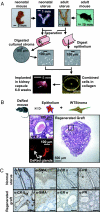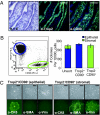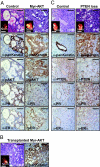Cell-autonomous activation of the PI3-kinase pathway initiates endometrial cancer from adult uterine epithelium
- PMID: 20855612
- PMCID: PMC2951427
- DOI: 10.1073/pnas.1012548107
Cell-autonomous activation of the PI3-kinase pathway initiates endometrial cancer from adult uterine epithelium
Abstract
Epithelial-specific activation of the PI3-kinase pathway is the most common genetic alteration in type I endometrial cancer. In the majority of these tumors, PTEN expression is lost in the epithelium but maintained in tumor stroma. Currently reported PTEN knockout mouse models initiate type I endometrial cancer concomitant with loss of PTEN in both uterine epithelium and stroma. Consequently, the biologic outcome of selectively activating the PI3-kinase pathway in the endometrial epithelium remains unknown. To address this question, we established a malleable in vivo endometrial regeneration system from dissociated murine uterine epithelium and stroma. Regenerated endometrial glands responded to pharmacologic variations in hormonal milieu similar to the native endometrium. Cell-autonomous activation of the PI3-kinase pathway via biallelic loss of PTEN or activation of AKT in adult uterine epithelia in this model was sufficient to initiate endometrial carcinoma. AKT-initiated tumors were serially transplantable, demonstrating permanent genetic changes in uterine epithelia. Immunohistochemistry confirmed loss of PTEN or activation of AKT in regenerated hyperplastic glands that were surrounded by wild-type stroma. We demonstrate that cell-autonomous activation of the PI3-kinase pathway is sufficient for the initiation of endometrial carcinoma in naive adult uterine epithelia. This in vivo model provides an ideal platform for testing the response of endometrial carcinoma to targeted therapy against this common genetic alteration.
Conflict of interest statement
The authors declare no conflict of interest.
Figures




Similar articles
-
Activated mutant p110α causes endometrial carcinoma in the setting of biallelic Pten deletion.Am J Pathol. 2015 Apr;185(4):1104-13. doi: 10.1016/j.ajpath.2014.12.019. Epub 2015 Feb 16. Am J Pathol. 2015. PMID: 25698082 Free PMC article.
-
The uterine epithelial loss of Pten is inefficient to induce endometrial cancer with intact stromal Pten.PLoS Genet. 2018 Aug 24;14(8):e1007630. doi: 10.1371/journal.pgen.1007630. eCollection 2018 Aug. PLoS Genet. 2018. PMID: 30142194 Free PMC article.
-
Crosstalk between PKCα and PI3K/AKT Signaling Is Tumor Suppressive in the Endometrium.Cell Rep. 2018 Jul 17;24(3):655-669. doi: 10.1016/j.celrep.2018.06.067. Cell Rep. 2018. PMID: 30021163 Free PMC article.
-
Role of Tumor Suppressor PTEN and Its Regulation in Malignant Transformation of Endometrium.Biochemistry (Mosc). 2022 Nov;87(11):1310-1326. doi: 10.1134/S0006297922110104. Biochemistry (Mosc). 2022. PMID: 36509719 Review.
-
Lab review: Molecular dissection of the signal transduction pathways associated with PTEN deletion-induced optic nerve regeneration.Restor Neurol Neurosci. 2019;37(6):545-552. doi: 10.3233/RNN-190949. Restor Neurol Neurosci. 2019. PMID: 31839616 Free PMC article. Review.
Cited by
-
Loss of CDH1 and Pten accelerates cellular invasiveness and angiogenesis in the mouse uterus.Biol Reprod. 2013 Jul 11;89(1):8. doi: 10.1095/biolreprod.113.109462. Print 2013 Jul. Biol Reprod. 2013. PMID: 23740945 Free PMC article.
-
An inducible knockout mouse to model the cell-autonomous role of PTEN in initiating endometrial, prostate and thyroid neoplasias.Dis Model Mech. 2013 May;6(3):710-20. doi: 10.1242/dmm.011445. Epub 2013 Feb 8. Dis Model Mech. 2013. PMID: 23471917 Free PMC article.
-
Regulated proteolysis of Trop2 drives epithelial hyperplasia and stem cell self-renewal via β-catenin signaling.Genes Dev. 2012 Oct 15;26(20):2271-85. doi: 10.1101/gad.196451.112. Genes Dev. 2012. PMID: 23070813 Free PMC article.
-
A dual PI3K/AKT/mTOR signaling inhibitor miR-99a suppresses endometrial carcinoma.Am J Transl Res. 2016 Feb 15;8(2):719-31. eCollection 2016. Am J Transl Res. 2016. PMID: 27158364 Free PMC article.
-
Two-Way Development of the Genetic Model for Endometrial Tumorigenesis in Mice: Current and Future Perspectives.Front Genet. 2021 Dec 9;12:798628. doi: 10.3389/fgene.2021.798628. eCollection 2021. Front Genet. 2021. PMID: 34956336 Free PMC article. Review.
References
-
- Jemal A, et al. Cancer statistics, 2009. CA Cancer J Clin. 2009;59:225–249. - PubMed
-
- Bokhman JV. Two pathogenetic types of endometrial carcinoma. Gynecol Oncol. 1983;15(1):10–17. - PubMed
-
- Stambolic V, et al. High incidence of breast and endometrial neoplasia resembling human Cowden syndrome in pten+/− mice. Cancer Res. 2000;60:3605–3611. - PubMed
Publication types
MeSH terms
Substances
Grants and funding
LinkOut - more resources
Full Text Sources
Other Literature Sources
Molecular Biology Databases
Research Materials

